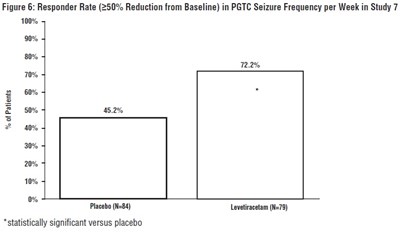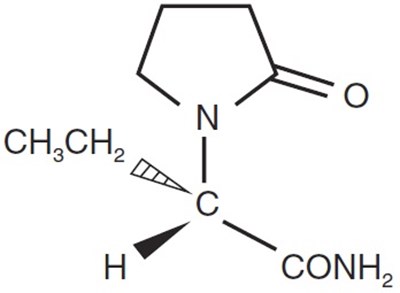Product Images Levetiracetam
View Photos of Packaging, Labels & Appearance
Product Label Images
The following 8 images provide visual information about the product associated with Levetiracetam NDC 50090-5760 by A-s Medication Solutions, such as packaging, labeling, and the appearance of the drug itself. This resource could be helpful for medical professionals, pharmacists, and patients seeking to verify medication information and ensure they have the correct product.
Figure 1: Responder Rate (≥50% Reduction from Baseline) in Study 1 - levetiracetam fig1

This is a figure (Figure 1) depicting the Responder Rate in Study 1 with a reduction of 250% from baseline. It shows a graph with percentages ranging from 0% to 39.6%, and two different treatments, Leviaseam 100 and Leviaseam 000, both of which are statistically significant versus placebo.*
Figure 2: Responder Rate (≥50% Reduction from Baseline) in Study 2: Period A - levetiracetam fig2

This is a figure from a medical study, showing the responder rate (250% reduction from baseline) in Study 2 period A. The figure displays the percentage of patients who responded to the treatment on the Y-axis, ranging from 0% to 40%. The X-axis shows the three groups of patients: placebo (N=111), Levetiracetam 1000 mg/day (N=106), and Levetiracetam 2000 mg/day (N=105). The asterisk (*) indicates that the difference between the groups taking Levetiracetam 2000 mg/day and placebo was statistically significant.*
Figure 3: Responder Rate (≥50% Reduction from Baseline) in Study 3 - levetiracetam fig3

This is a statistical figure from Study 3 showing the responder rate (>50% reduction from baseline) for a certain treatment. The placebo group (with 104 individuals) had a responder rate of 14.4%, while the group treated with 3000 mg/day of Levetiracetam (with 180 individuals) had a responder rate of 45%, which is considered statistically significant compared to the placebo group.*
Figure 4: Responder Rate (≥ 50% Reduction from Baseline) in Study 4 - levetiracetam fig4

The text describes a figure (Figure 4) that shows the responder rate in Study 4 where the percentage of reduction from baseline is 250%. There are two bars in the figure representing the placebo (N=97) and Levetiracetam (N=101) groups. The Levetiracetam group had a statistically significant result when compared to the placebo group. The text does not provide any additional information.*
Figure 5: Responder Rate for All Patients Ages 1 Month to < 4 Years (≥ 50% Reduction from Baseline) in Study 5 - levetiracetam fig5

The figure shows the Responder Rate for patients between 1 month to less than 4 years old, with a reduction of over 50% from the baseline in Study 5. The percentage of responders is 190.6% for those treated with Lovetracatam and 0% for those who received placebo. Lovetracatam showed a statistically significant improvement compared to placebo.*
Figure 6: Responder Rate (≥50% Reduction from Baseline) in PGTC Seizure Frequency per Week in Study 7 - levetiracetam fig6

The image shows the responder rate for PGTC seizure frequency per week in Study 7, indicating that Levetiracetam was statistically significant versus placebo with a 250% Reduction from Baseline. The graph shows that 72.2% of patients in the Levetiracetam group had a 50% or higher reduction in seizure frequency, compared to 45.2% in the placebo group. The image also shows the number of patients in each group and the percentage of responders.*
* The product label images have been analyzed using a combination of traditional computing and machine learning techniques. It should be noted that the descriptions provided may not be entirely accurate as they are experimental in nature. Use the information in this page at your own discretion and risk.

